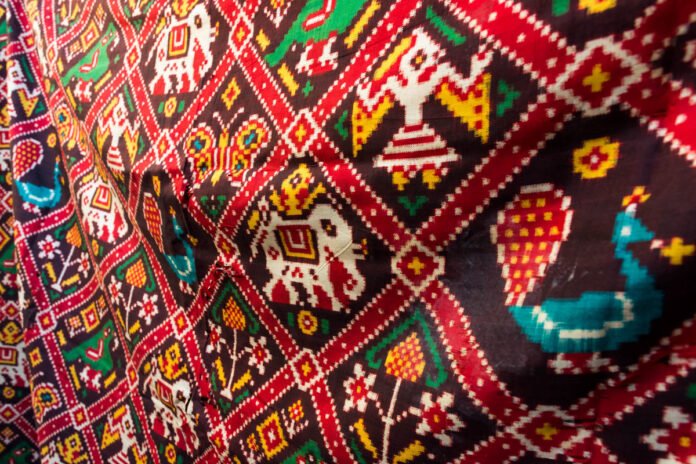From the tombs of ancient pharaohs to modern fashion runways, ikat has woven its way through time, preserving stories and traditions with every thread. In a bustling marketplace, sunlight catches on a woman’s sari, its intricate patterns shimmering like a desert mirage. This is ikat, a captivating Indian textile where the resist-dyed threads don’t just capture its beauty but also whisper the tales of history and artistry.
According to Professor John Varghese of the School of Fashion at World University of Design (WUD) in Sonipat, the oldest surviving fragment of ikat was discovered in the tomb of an Egyptian pharaoh, suggesting its antiquity and early global reach. This particular piece was traced back to the Indian state of Odisha, highlighting India’s rich textile heritage, he said. The discovery underscores the historic trade connections between India and Egypt, where Indian textiles were highly prized commodities.
Ikat, known for its complex and labor-intensive dyeing technique, involves binding individual threads with a resist before dyeing them. The threads are then woven to create intricate patterns. This method requires precision and skill, resulting in textiles that are both visually stunning and culturally significant. The patterns often carry symbolic meanings and represent the heritage and identity of the region they originate from.
In India, ikat is predominantly produced in states like Odisha, Andhra Pradesh, and Gujarat, each with its unique style and technique. The ikat from Odisha, known as “bandha,” is renowned for its fluid and curvilinear designs, often inspired by nature and mythology. Andhra Pradesh’s Pochampally ikat features geometric patterns, while Gujarat’s Patan Patola is famous for its double ikat technique, considered one of the most intricate and prestigious forms of ikat.
Despite the advent of modern technology, traditional ikat weaving continues to thrive, supported by artisans dedicated to preserving this ancient craft. The global fashion industry has also embraced ikat, incorporating its distinctive patterns into contemporary designs, thus ensuring its relevance in the modern era.
The journey of ikat from an Egyptian pharaoh’s tomb to the wardrobes of fashion enthusiasts worldwide is a testament to its enduring appeal and the timeless beauty of Indian textiles. This ancient art form not only reflects the ingenuity of its creators but also serves as a bridge connecting cultures across time and geography.
In contemporary fashion, ikat has found a resurgence among designers who value its rich heritage and intricate patterns. Major fashion houses and independent designers alike have showcased ikat in their collections, blending traditional craftsmanship with modern aesthetics. This fusion has introduced ikat to a global audience, ensuring its continued popularity and relevance.
Artisans who create ikat textiles often work in small, family-run workshops, passing down their skills through generations. The process is meticulous, involving several stages of dyeing and weaving that require both patience and precision. Each piece of ikat fabric tells a story, not only of its design but also of the hands that crafted it. This personal connection to the textile adds a layer of depth and meaning, making ikat pieces cherished heirlooms.
Despite its popularity, ikat faces challenges in the modern world. The rise of fast fashion and mass-produced textiles has put pressure on traditional artisans, who struggle to compete with cheaper, machine-made fabrics. Efforts to preserve and promote ikat involve collaborations between artisans and designers, fair trade practices, and initiatives to educate consumers about the value of handmade textiles.
Governments and non-profit organizations also play a crucial role in supporting ikat artisans. In India, various schemes and programs aim to provide financial assistance, training, and market access to weavers. These efforts help sustain the art of ikat and improve the livelihoods of those who depend on it. Additionally, international trade fairs and exhibitions offer platforms for artisans to showcase their work to a broader audience, fostering appreciation and demand for ikat.
The cultural significance of ikat extends beyond its aesthetic appeal. In many regions, ikat garments are worn during important ceremonies and festivals, symbolizing identity, tradition, and continuity. The motifs and colors used in ikat designs often have specific meanings, reflecting local beliefs and customs. By wearing ikat, individuals not only celebrate their heritage but also support the artisans who keep these traditions alive.
As ikat continues to captivate people around the world, it serves as a reminder of the beauty and complexity of human creativity. Its journey from ancient times to the present day illustrates the enduring power of art and culture to transcend boundaries and connect us to our shared history.

